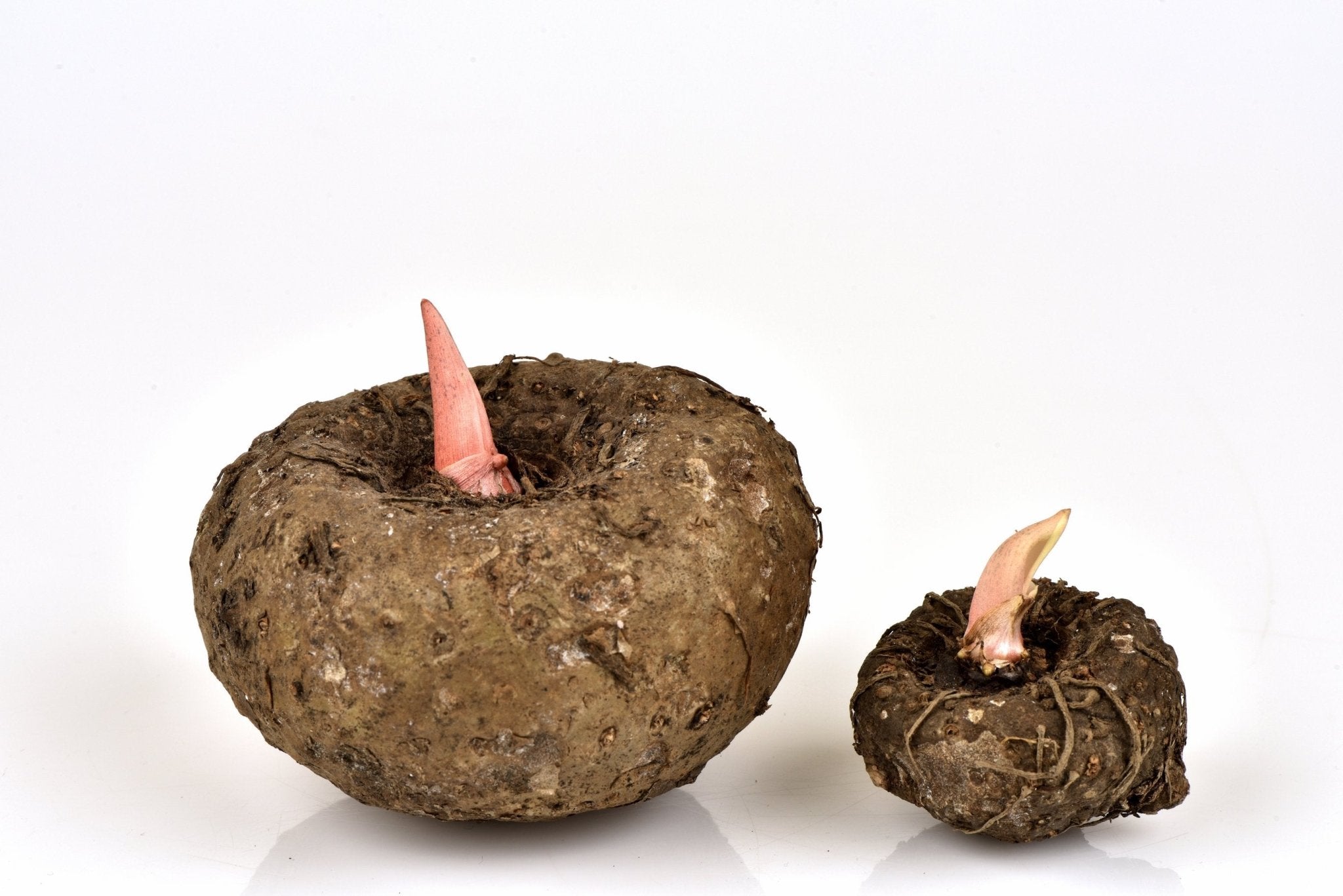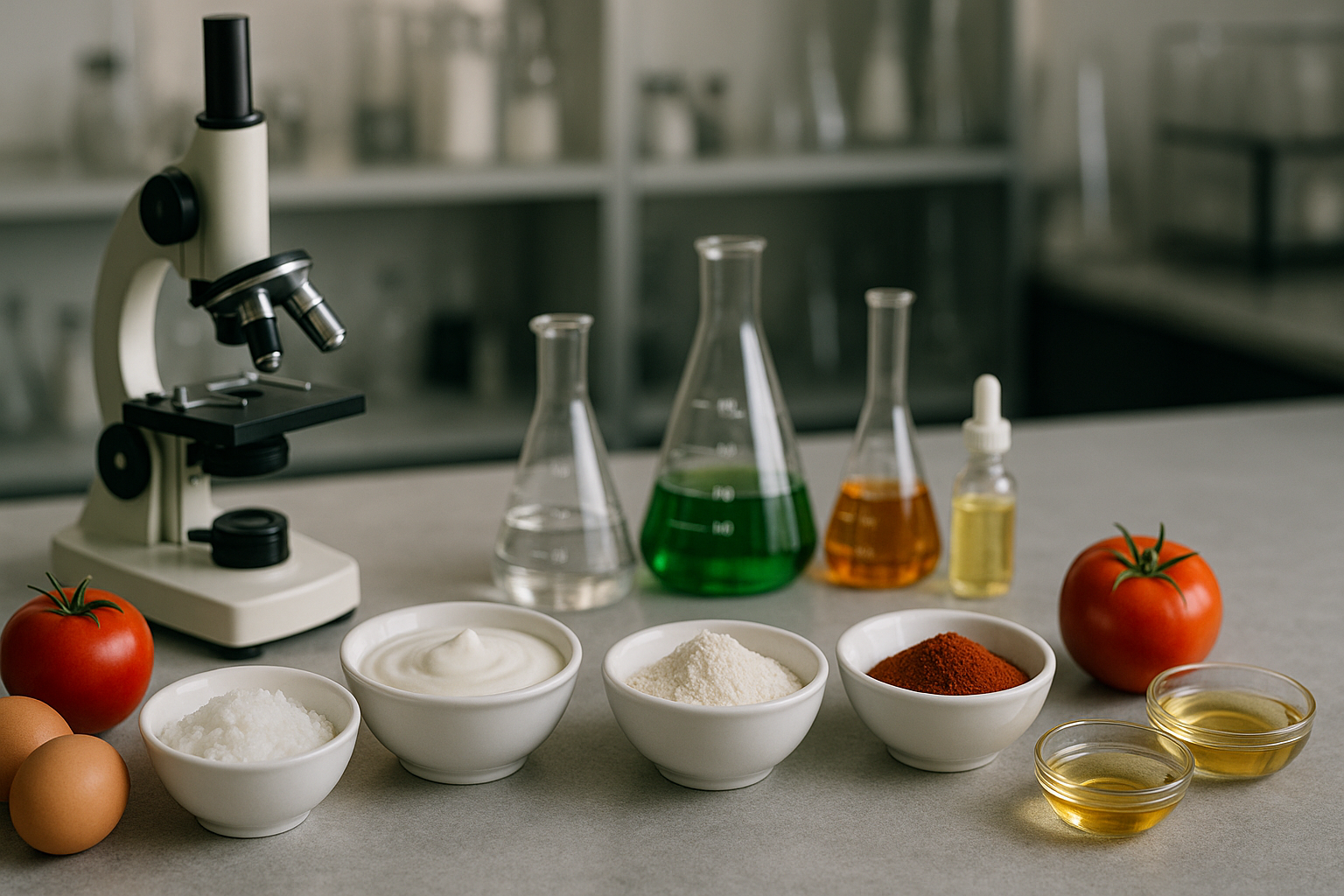
Unlocking the Secret of Konjac Gum - The Many Benefits in Your Recipes
SUBSCRIBE TO OUR BLOG
Promotions, new products, and recipes.
When it comes to cooking and baking, the pursuit of creating delicious and wholesome dishes is a never-ending endeavor. With a growing focus on healthy eating, there is a constant quest for innovative and natural ingredients that can elevate our culinary creations. In recent years, konjac gums have emerged as a game-changer, revolutionizing the way we approach recipes. This humble ingredient has proven to be a versatile and beneficial addition to various dishes, offering a range of advantages that not only enhance taste and texture but also promote better health. In this article, we will delve into the many benefits of konjac gum in your recipes.
What is Konjac Gum?
Before we explore its benefits, it's essential to understand what konjac gum is. Konjac gum, also known as glucomannan, is derived from the root of the konjac plant (Amorphophallus konjac). Native to Southeast Asia, the konjac plant has been used for centuries in traditional Asian cuisine and medicine. The gum is extracted from the plant's corm (a bulb-like structure) and processed into a fine white powder, which is used as a thickening agent and stabilizer in various recipes. We have listed a number of tasty and many sugar-free recipes using konjac gum that you can read here.
What is the Source of Konjac Gum?
Konjac gum comes from the root of the konjac plant (Amorphophallus konjac). The konjac plant is native to Southeast Asia and is primarily grown in countries like China, Japan, Korea, and Indonesia.
The konjac plant is a perennial plant that belongs to the family Araceae. It has large, single leaves and produces a unique flowering structure known as an inflorescence. The edible part of the konjac plant is the corm, which is an underground bulb-like structure. The corm is rich in a water-soluble dietary fiber called glucomannan, which is the main component of konjac gum.
The konjac plant has been utilized in traditional Asian cuisine and medicine for centuries due to its various health benefits and culinary properties. In recent years, konjac gum has gained popularity globally as a natural and functional ingredient in various recipes, especially for those seeking gluten-free, low-calorie, or low-carb alternatives.
How is Konjac Gum Powder Produced?
Since Konjac gum powder is plant based it is considered non-GMO. The end product, which is a white powder, is created through a series of processes that involve extracting the gum from the konjac plant's corm (the underground bulb-like structure) and converting it into a fine white powder. Here's a step-by-step overview of how konjac gum powder is typically produced:
Harvesting the Konjac Plant: The first step in creating konjac gum powder is harvesting the konjac plant, scientifically known as Amorphophallus konjac. The konjac plant is native to Southeast Asia and is primarily grown in countries like China, Japan, Korea, and Indonesia.
Cleaning and Peeling: Once harvested, the konjac corms are cleaned to remove any dirt or impurities. The outer layer of the corms is then peeled off, leaving behind the starchy inner part.
Slicing or Shredding: After peeling, the konjac corms are sliced or shredded into small pieces. This process increases the surface area and facilitates the extraction of the gum later on.
Alkaline Treatment: The sliced or shredded konjac pieces are soaked in an alkaline solution, typically made from calcium hydroxide or potassium hydroxide. This treatment helps to break down the plant's cell walls and release the konjac gum.
Rinse and Neutralize: After the alkaline treatment, the konjac pieces are thoroughly rinsed to remove any residual alkaline solution. They are then neutralized with an acidic solution, usually citric acid, to bring the pH level back to a neutral range.
Purification and Filtering: The neutralized konjac pieces are boiled in water to extract the konjac gum. The mixture is then filtered to remove any remaining solid particles, resulting in a konjac gum solution.
Concentration and Cooling: The filtered konjac gum solution is concentrated by evaporating the water, resulting in a thickened gum solution. This concentrated solution is then cooled to form a gel-like substance.
Drying: The gel-like konjac gum is subjected to spray drying or other drying methods to remove the remaining moisture. This process transforms the gel into a fine powder, which is the konjac gum powder that we commonly see in the market.
Milling and Packaging: The dried konjac gum powder is milled to achieve the desired particle size and consistency. Finally, it is packaged and ready for distribution and use in various food and industrial applications.
It's worth noting that during this production process, some manufacturers may also modify the konjac gum to create derivatives with specific properties, such as high-viscosity konjac gum or modified konjac gum with improved stability in certain applications. The resulting konjac gum powder is an essential and versatile ingredient used in a wide range of food products, including as a thickener, stabilizer, and gelling agent.
The Many Benefits of Konjac Gum
Excellent Thickening Agent
One of the primary benefits of konjac gum is its exceptional ability to thicken liquids. When mixed with water or other liquids, konjac gum forms a gel-like substance, which adds viscosity to soups, sauces, gravies, and even desserts. Unlike some conventional thickeners, such as cornstarch or flour, konjac gum doesn't require heat to reach its full thickening potential. This makes it an ideal choice for recipes that call for cold or low-temperature preparation.
Gluten-Free Alternative
For individuals with gluten sensitivity or celiac disease, finding suitable alternatives to wheat-based ingredients can be challenging. Konjac gum comes to the rescue as a naturally gluten-free thickener, making it an excellent substitute for traditional thickeners like wheat flour. By incorporating konjac gum into your recipes, you can maintain the desired consistency without compromising on taste or dietary requirements. We have written another article that you will find helpful on selecting various gums for your recipes including Konjac gum, you find here, How to Select the Perfect Gum for Any Recipe.
Low Calorie for the Carb Conscious
Another remarkable benefit of konjac gum is its low-calorie and low-carb content. It is virtually calorie-free, making it an appealing option for those striving to reduce caloric intake without sacrificing flavor or texture. Additionally, konjac gum is a soluble fiber, which means it can aid in digestion and provide a sense of fullness, potentially assisting in weight management efforts.
Enhances Textures and Mouthfeel
The addition of konjac gum in recipes can significantly improve the texture and mouthfeel of various dishes. Whether you're making creamy soups, smooth sauces, or rich desserts, konjac gum helps create a smoother, silkier consistency. In dairy-free or vegan recipes, konjac gum can be particularly useful in replicating the creaminess typically achieved with milk or cream.
Provides Stability in Frozen and Refrigerated Products
Konjac gum's ability to form a stable gel at low temperatures makes it an excellent choice for frozen and refrigerated products. Ice creams and frozen desserts, in particular, benefit from the addition of konjac gum, preventing ice crystallization and maintaining a smooth texture during storage.
There are Reported Health Benefits
Beyond its culinary advantages, konjac gum boasts various health benefits. As a soluble fiber, it can help regulate blood sugar levels, making it beneficial for individuals with diabetes. Moreover, konjac gum has been linked to improved gut health by promoting beneficial gut bacteria, easing constipation, and supporting overall digestive function.
It Is Allergen-Free and Vegan-Friendly
Konjac gum is naturally free from common allergens, such as soy, nuts, dairy, and eggs, making it a safe choice for those with food allergies or intolerances. Moreover, being plant-based, it aligns with vegan and vegetarian dietary preferences.

How It Enhances Your Recipes
Due to its unique properties, konjac powder finds applications in both sweet and savory recipes. Here are some common ways konjac powder is used in cooking:
Thickening Sauces and Gravies:
Konjac powder is an excellent thickening agent that can be used to thicken sauces, gravies, and soups. Unlike some traditional thickeners that require heat, konjac powder can thicken cold or room-temperature liquids. To use it as a thickener, first, mix the konjac powder with a small amount of cold water to form a smooth slurry, then add the slurry to the sauce or gravy while stirring continuously. The konjac powder will quickly thicken the liquid, providing a smooth and glossy consistency.
Making Jellies and Gels:
Konjac powder can be used to create jellies, puddings, and gels in desserts. By dissolving konjac powder in hot liquid and allowing it to cool and set, you can create a firm and stable gel without the need for gelatin or other animal-derived gelling agents. This makes it a great option for those following a vegetarian or vegan diet.
Gluten-Free Baking:
For individuals who are gluten-sensitive or have celiac disease, konjac powder serves as an excellent gluten-free alternative to wheat-based thickeners like flour. It can be used in gluten-free baking to provide structure and texture to bread, cakes, muffins, and other baked goods. However, it's important to note that konjac powder's unique gelling properties can affect the texture of baked goods, so recipes may need to be adjusted accordingly.
Improving Texture in Low-Calorie and Low-Carb Dishes:
Konjac powder is often used in low-calorie and low-carb recipes to improve texture and mouthfeel. It can be added to dishes like low-carb pasta and noodles to give them a more satisfying and pasta-like consistency without the added calories or carbs.
Stabilizing Ice Cream and Frozen Desserts:
In frozen desserts like ice cream, konjac powder can help prevent the formation of ice crystals and stabilize the texture during storage. Its ability to form a stable gel at low temperatures makes it an ideal addition to frozen treats.
Binding and Coating Ingredients:
When used in combination with other ingredients, konjac powder can act as a binder to help hold ingredients together. It can be used to create vegan meat substitutes, where it helps bind ingredients like vegetables and proteins together to form a cohesive texture. Additionally, konjac powder can be used as a coating for fried foods, providing a crispy outer layer.
Enhancing Health and Nutrition:
Apart from its culinary applications, konjac powder is valued for its potential health benefits. As a soluble fiber, it can help regulate blood sugar levels, promote satiety, and support digestive health.
When using konjac powder in cooking, it's essential to follow the recommended proportions to achieve the desired results. Since konjac powder absorbs a significant amount of water, using too much of it can lead to an overly thick or gummy texture in your dishes. As with any new ingredient, it's best to start with small quantities and gradually increase as you become familiar with its properties and effects on your recipes.
Konjac Gum Pros and Cons
Using konjac gum in cooking and baking offers a number of advantages, but there are also some considerations to keep in mind. Here are the pros and cons of using konjac gum:
Pros:
Thickening Agent: Konjac gum is an excellent thickener, and it works efficiently in cold or hot liquids. It helps achieve desired consistency in sauces, gravies, soups, and other dishes without the need for high temperatures.
Gluten-Free Alternative: For individuals with gluten sensitivity or celiac disease, konjac gum serves as a safe and gluten-free thickening agent and stabilizer in various recipes.
Low-Calorie and Low-Carb: Konjac gum is virtually calorie-free and low in carbohydrates, making it an appealing option for those aiming to reduce caloric and carb intake without sacrificing texture or taste.
Gel Formation: It can create stable and smooth gels and jellies in desserts without using animal-based gelling agents like gelatin, making it suitable for vegetarians and vegans.
Stability in Frozen Products: Konjac gum can enhance the texture of frozen desserts like ice cream, preventing ice crystallization and maintaining a smoother consistency during storage.
Health Benefits: As a soluble fiber, konjac gum can contribute to better digestive health, regulate blood sugar levels, and aid in weight management by promoting a feeling of fullness.
Allergen-Free: Konjac gum is naturally free from common allergens such as soy, nuts, dairy, and eggs, making it safe for individuals with food allergies or intolerances.
Cons:
Gelling Properties: The gelling properties of konjac gum can sometimes affect the texture and taste of dishes, especially in gluten-free baking. It may require recipe adjustments to achieve the desired results.
Quantity Sensitivity: Konjac gum is highly absorbent and swells in liquids, so using too much of it can lead to an overly thick or gummy consistency in dishes.
Gastrointestinal Distress: In some individuals, consuming large amounts of konjac gum can lead to gastrointestinal discomfort, including bloating, gas, and diarrhea. It is crucial to use it in moderation.
Learning Curve: Due to its unique properties, using konjac gum may require some experimentation and familiarity to achieve the desired results in recipes.
Availability and Cost: Konjac gum may not be as readily available as common thickeners, and it could be relatively more expensive, which might impact its usage in some recipes.
Lack of Browning: Unlike some other thickeners like flour or cornstarch, konjac gum does not contribute to browning in cooking or baking, which may affect the appearance of certain dishes.
Risk of Choking: Konjac gum, when used to make jelly-like substances, can present a choking hazard, especially for young children or individuals with swallowing difficulties. It is essential to use it responsibly and follow safety guidelines.
Konjac gum is a valuable and versatile ingredient in cooking and baking, offering numerous benefits for those seeking gluten-free, low-calorie, or low-carb alternatives. However, it requires thoughtful and moderate use to avoid potential drawbacks, such as undesirable texture and gastrointestinal discomfort. As with any new ingredient, it's best to start with small quantities and gradually incorporate it into your recipes to experience the full advantages of konjac gum without compromising the overall quality of your culinary creations.
Where can Konjac Gum Be Obtained?
Konjac gum can be obtained from various sources, including physical stores and online retailers. Here are some common places where you can find konjac gum:
Health Food Stores: Many health food stores and specialty grocery stores carry konjac gum in their baking or gluten-free sections. Look for it among other gluten-free flours and thickeners.
Online Retailers: One of the easiest ways to find konjac gum is by shopping online. Numerous online retailers, such as Amazon, Walmart, Cape Crystal Brands, and specialty food stores, offer a wide range of konjac gum products that can be delivered directly to your doorstep.
Asian Grocery Stores: If you have access to Asian grocery stores or specialty stores that focus on Asian ingredients, you are likely to find konjac gum there. Since konjac is native to Southeast Asia, these stores often carry various konjac products.
Health and Wellness Websites: Many websites dedicated to health and wellness products may also offer konjac gum for purchase. These sites may provide detailed information about the product's benefits and uses.
Natural Food Co-ops: If you are a member of a natural food co-op or local health-oriented cooperative, they may stock konjac gum in their bulk bins or specialty sections.
When purchasing konjac gum, be sure to check the product label for quality and purity. Look for 100% pure konjac gum without added preservatives or fillers. Additionally, consider the quantity you need for your recipes, as konjac gum can be quite potent in small amounts due to its thickening properties.
Keep in mind that the availability of konjac gum may vary depending on your location and the stores in your area. If you can't find it locally, online shopping offers a convenient and reliable way to obtain konjac gum and have it delivered directly to your home.
Conclusion
In conclusion, konjac gums are a remarkable addition to any culinary repertoire. Their unique properties as a thickening agent, gluten-free alternative, and low-calorie option make them an invaluable ingredient for health-conscious individuals and those with dietary restrictions. Not only do they enhance the taste and texture of your dishes, but they also offer various health benefits, promoting better digestion and gut health.
As with any ingredient, moderation is key. While konjac gum is safe for most people, excessive consumption may lead to gastrointestinal discomfort. As you experiment with this versatile ingredient, be sure to enjoy the many benefits of konjac gums while savoring the delightful dishes they help you create. So, next time you embark on a culinary adventure, don't forget to unlock the secret of konjac gum and take your recipes to new heights!
What has been your experience with gluten-free baking have you experimented with konjac gum? Please share with us in the comments section below!


|
About the Author Ed is the founder of Cape Crystal Brands, editor of the Beginner’s Guide to Hydrocolloids, and a passionate advocate for making food science accessible to all. Discover premium ingredients, expert resources, and free formulation tools at capecrystalbrands.com/tools. — Ed |
Enjoyed this post? Subscribe to The Crystal Scoop
Food-science tips, ingredient know-how, and recipes. No spam—unsubscribe anytime.
- Choosing a selection results in a full page refresh.



